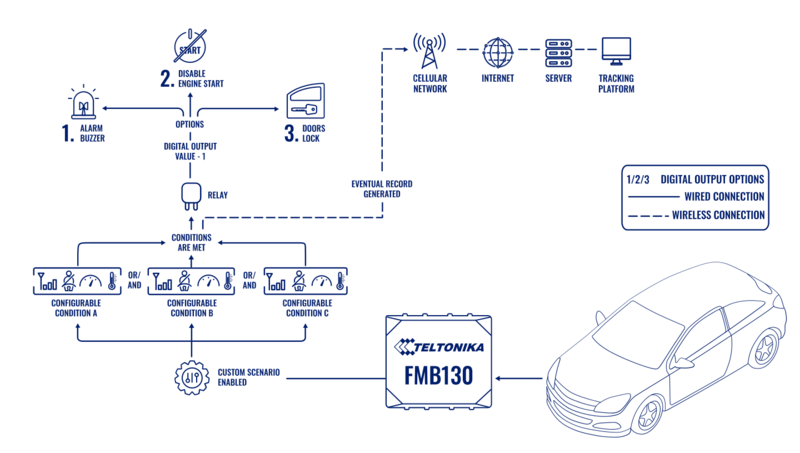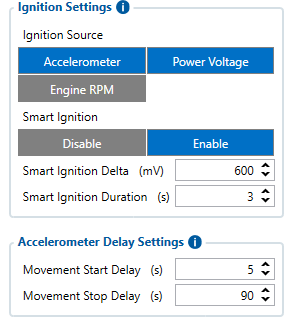Custom Scenarios
Introduction to Custom Scenarios functionality
To meet the diverse and evolving needs of our clients, we have developed the Custom Scenarios feature. This solution allows users to define specific conditions using customizable parameters to trigger events or control a device’s digital outputs. By connecting the device to peripherals like alarms, buzzers, or relays, this functionality can notify drivers or perform targeted actions seamlessly.
The feature enables the device to operate autonomously based on predefined conditions, eliminating the need for constant monitoring of device status or complex backend integrations. With Custom Scenarios, any data the device can read becomes a potential input for controlling digital outputs, providing flexibility and efficiency.
Custom Scenarios functionality logic
The Custom Scenarios functionality enables configuration of up to three independent scenarios, each with up to three unique triggers. Triggers are defined using data from various I/O elements, such as: Fuel Level, Engine RPM, Seatbelt Status, DTC Faults, Movement Status, Ignition State, GSM Signal Level, 1-Wire/Bluetooth sensor temperature and etc. Each trigger is configured with specific logic operands (e.g., "On Entrance," "On Exit"), threshold values (Low and High levels), and an activation delay timer, which specifies how long a value must remain within the defined range before the trigger is activated.
When all triggers of a scenario evaluate as true, the scenario becomes active. This can generate a record (if configured) and control the digital output (DOUT) by toggling it on or off based on the active conditions. Additionally, if configured for continuous operation, the DOUT remains active as long as the conditions are met.
Key features include:
- Support for dynamic trigger logic based on selected operands and conditions.
- Autonomous device operation, even in low-power or deep-sleep modes, provided compatible I/O sources are used.
- Adjustable ON/OFF durations or permanent output control, enabling versatile device behaviors such as blinking or continuous activation.
- Custom Scenarios operate independently from the I/O menu, with priority management ensuring that higher-priority scenarios take precedence in controlling the DOUT when multiple scenarios are configured.
Custom Scenarios functionality configuration
New configurable parameters were added under “Ignition Settings” (Figure 2):
• Smart Ignition Enable/Disable – To enable functionality. Parameter is able to be configured if “Ignition Source” has “Power Voltage” configured.
• Smart Ignition Delta (mV) – How much external voltage must change to detect ignition ON or OFF event.
• Smart Ignition Duration (s) – Time interval used for comparing current external voltage against historical external voltage configured seconds ago.
In case the vehicle has a variable voltage alternator, also known as a smart alternator, an alternative configuration is advised -- taking into account movement detection by accelerometer, in order to monitor the ignition status of the vehicle.
Parameter list
| Parameter ID | Name | Value range | Description | ||
|---|---|---|---|---|---|
| Min | Max | Default | |||
| 66201 | Smart Ignition | 0 | 1 | 1 | 0 - Disabled; 1 - Enabled |
| 66202 | Smart Ignition Delta, mV | 100 | 2000 | 600 | How much external voltage must change, in miliVolts to detect ignition ON or OFF event. |
| 66203 | Smart Ignition Duration, s | 2 | 20 | 3 | Time interval, in seconds, used for comparing current external voltage against historical external voltage configured seconds ago. |
Firmware and hardware compatibility
Smart ignition detection functionality is available for FMT100/FMX880 devices on the firmware 03.29.00.rev.980. You can download the firmware and configurator here. ![]()


